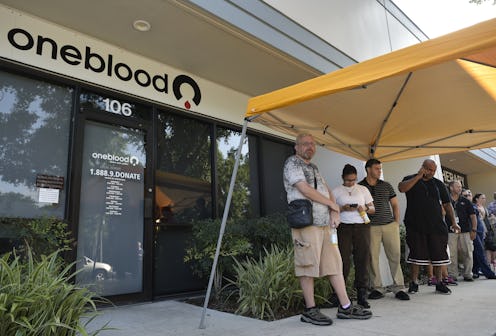News
Non-Celibate Gay Men Are Years From Donating Blood
One of the biggest signs of solidarity in response to the Orlando shooting was a spike in blood donations. People waited hours in line to donate — so many people, in fact, that blood banks reached capacity and asked donors to return in coming days. Very few of those donating, however, were gay or bisexual men due to FDA restrictions on gay donors — even though the LGBT community was the target of the attacks. Activists would like to see those curbs go, but some health experts told Reuters that lifting restrictions on gay blood donors could take years.
The FDA's official position is that there is not enough scientific evidence to remove current restrictions. Per current policy, all men who have sex with men are required to wait 12 months after their last same-sex sexual encounter before donating. That was reduced in December from the lifetime ban that the U.S. Food and Drug Administration put into place during the AIDS epidemic of the 1980s.
"We empathize with those who might wish to donate, but reiterate that at this time no one who needs blood is doing without it," FDA spokesperson Tara Goodin said in a statement. "That being said, the FDA is committed to continuing to reevaluate its blood donor deferral policies as new scientific information becomes available."
Reuters quoted two researchers from the Blood Systems Research Institute in San Francisco. They claim the FDA will first need to study the change to the one-year waiting period before taking any further moves. Brian Custer, the associate director of BSRI, said they need to determine whether the end of the lifetime ban made the blood supply, more, less, or equally safe. Dr. Michael Busch, a co-director of BSRI, said that completely removing the waiting period would require a large-scale study testing samples of potential new donors. "Those are difficult to design and execute," he told Reuters.
That hasn't stopped some from pushing for an end to the ban, including several U.S. representatives. "The Orlando blood bank put out the call that they needed several kinds of blood, luckily donors stepped up. Of course, the friends, the loved ones, and even spouses of those directly affected were unable to give in that way," Rep. Jared Polis, a Democrat from Colorado, told CNN. He was the first openly gay elected freshman member of Congress (Bernie Frank came out while in office). With fellow Reps. Mike Quigley and Barbara Lee, he is writing a letter to the FDA asking them to end the ban.
Current U.S. policy is in step with the U.K., France, Australia, and the Netherlands. Spain and Italy are among the countries that do not have such limits on the same-sex sexual activity of donors. Donors there are asked about risky behavior like prostitution, intravenous drug use, and sexual activity with multiple partners. A study in Italy showed no significant increase in gay or bisexual HIV-positive donors after the policy changed from a blanket ban to an individual risk assessment.
Other researchers have said removing the celibacy requirement is scientifically feasible. Dr. Susan Buchbinder, director of the HIV research program for San Francisco General Hospital, called the FDA one-year celibacy requirement "overly conservative." And Dr. Paul Volberding, director of the AIDS Research Institute at the University of California, said the ban is not "not really supported by the facts.”
“The testing methods [for blood-borne diseases such as HIV] are just amazingly accurate. We don’t miss infected people,” Volberding told PBS NewsHour. “The window from the exposure to testing positive is as short as a few days.”
Still, the FDA claims there is a risk. "A history of male-to-male sexual contact was associated with a 62-fold increased risk for being HIV positive, whereas the increase in risk for a history of multiple sexual partners of the opposite sex in the last year was 2.3-fold," the FDA said in a statement. Even so, the NIH says that HIV can be detected in blood nine to 11 days after infection. Currently blood undergoes 13 tests, including 10 for diseases like HIV, syphilis, and hepatitis. The Centers for Disease Control and Prevention says the risk of being infected with HIV is about one in 1.5 million.
